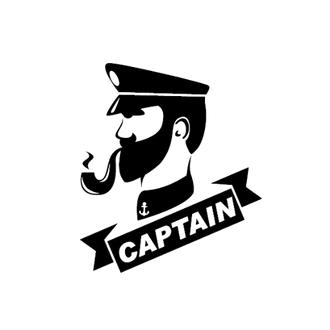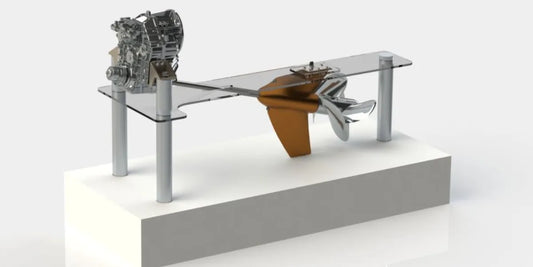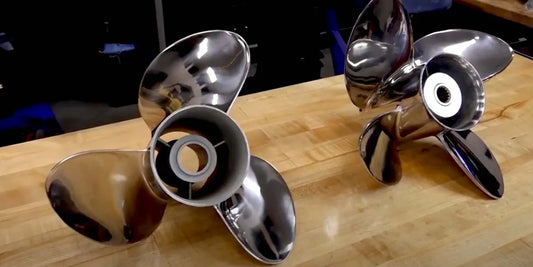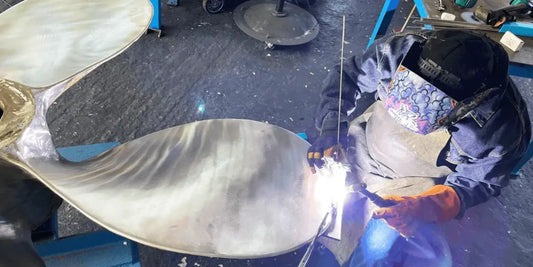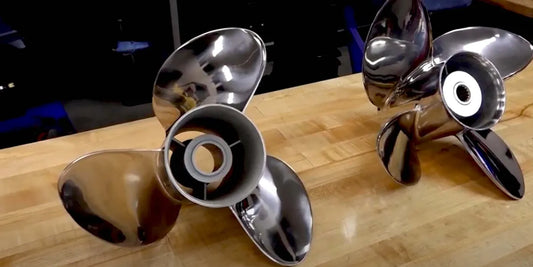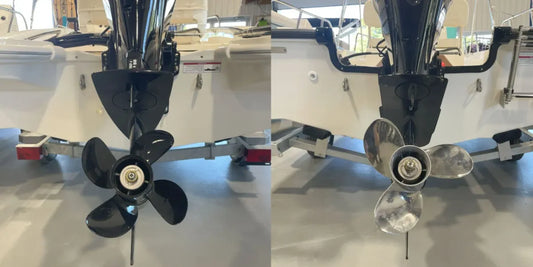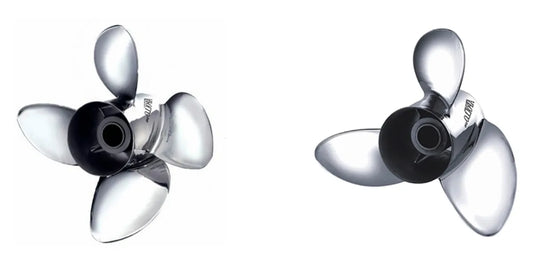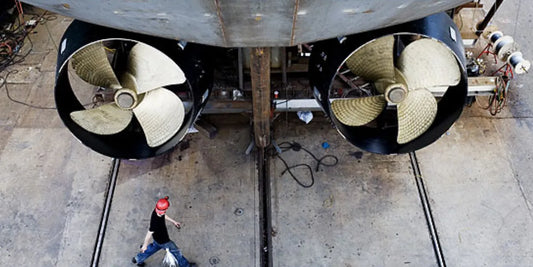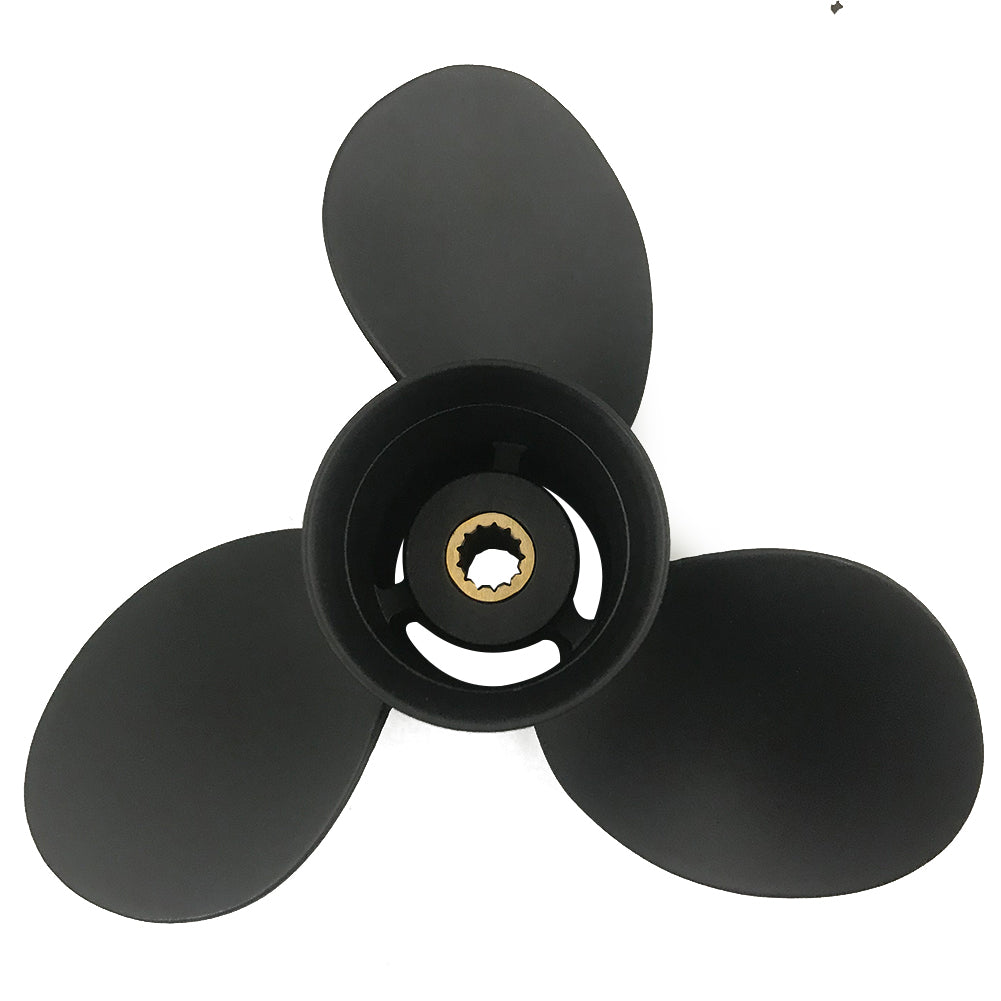When you are considering an upgrade for your boating activities, the first thought that comes to your mind should be the propellers. Propellers affect acceleration, fuel consumption, and handling. The debate between the two-blade propeller and the three-blade propeller is one of the most controversial, as both have their own benefits, depending on your boating needs, the type of equipment, and working conditions. This article delves into the primary differences between two-blade and three-blade propellers to understand the variations in application, particularly in terms of speed, thrust, and overall efficiency. If you are into power for water sports or perhaps smooth cruising for long outings, this guide will equip you with everything to make the best-informed decision in propelling your boat to a higher level of performance.
Understanding Propeller Types

What Is a 3-Blade Propeller?
The 3-blade propeller stands among the standard selections for marine vessels, with the trade-off between performance, efficiency, and durability. It consists of three blades, equidistant from one another, that turn within a hub, imparting thrust by displacing water. The real advantage of a three-blade propeller lies in its ability to operate smoothly and deliver consistent performance at any speed.
The design is ideal for excellent handling, especially in mid-sized boats and personal watercraft. Research data reveal that a 3-blade propeller could push a boat to a higher top speed than a 4-blade one, mainly because it has fewer blades and, thus, less drag. Acceleration is good with a 3-blade prop, making it great for water skiing, wakeboarding, or simply cruising.
While contemplating the purchase of a 3-blade propeller, blade pitch, diameter, and material are all principal considerations in efficiency calculations. Most modern 3-blade propellers in use today are made of stainless steel or aluminum for their strength and corrosion resistance. This propeller would be an excellent choice for someone whose performance needs versatility and cannot afford to compromise speed or control.
What is a 4-Blade Propeller?
The 4-blade propeller is manufactured to ensure stability, smoother handling, and more thrust, making it a desirable option for almost any boating requirement. Compared to a 3-blade, the extra blade dampens vibrations and gives better performance in rough water, making it a good application for towing skiers or wakeboarders. Therefore, 4-blade propellers tend to provide better acceleration and have an edge when operating at lower speeds. They are also fairly efficient under higher loads, a situation that will benefit bigger crafts or boats carrying a significant payload. Usually made from materials such as stainless steel or fine aluminum, 4-blade propellers offer a fair compromise between durability and precision. At the same time, they might slightly decrease top-end speed, where the extra, larger surface area of drag is working against it. Yet, given their versatility from a performance standpoint, they are somewhat popular among boaters who value control and reliability above top speed.
Key Features of Bladed Propellers
Bladed propellers come with numerous features that enhance their performance, ensure the reliability of the propulsion system, and achieve compatibility across various marine applications. Each feature contributes to the capability of operating with utmost efficiency and longevity, thereby ensuring a complete pleasure for the boating experience.
Better Thrust Efficiency: Bladed propellers are engineered to provide maximum thrust, achieving smooth acceleration and improved maneuverability. Their well-thought-out surface areas reduce slippage and promote greater propulsion in rough water. For heavy-load vessels or those operating in strong currents, this means enhanced control and reduced engine strain.
Material Durability: Modern bladed propellers are made from high-strength materials, including stainless steel, aluminum, and composite alloys. These materials offer resistance to corrosion, impact damage, and wear due to prolonged exposure to saltwater, thus ensuring that the propeller is capable of withstanding rigorous use throughout its lifetime.
Optimized Blades for Specific Applications: Precision-engineered blade shapes and arrangements are tailored to meet the practical boating needs of speed, towing, or fuel efficiency. For example, three-blade propellers are often associated with high-speed applications, while four-blade configurations are well-suited for enhancing maneuverability and stability at lower speeds.
Minimizes Noise and Vibration: Changes in engineering and blade construction help minimize noise and vibrations from the propeller. The result is a very comfortable ride in a somewhat quieter atmosphere, especially vital considerations for recreational users and anglers who cherish peace on the water.
Fuel Efficiency: Well-designed propellers are flexible enough to reduce any power losses, thereby enhancing engine fuel efficiency. By modifying blade pitch and surface area, these propellers essentially enable vessels to travel farther on less fuel; hence, they are an ecological choice to consider for modern boaters.
Watercraft Versatility: Bladed propellers compete in performance with a wide range of watercraft, from small recreational boats to large commercial vessels. They adapt to inboard and outboard engines, thus performing different operational requirements.
Innovative Coatings and Designs: Some propellers feature protective treatments, such as anti-corrosion coatings or hydrophobic surfaces, to enhance propeller efficiency and service life. Such advances reduce the need for maintenance and help prevent the degradation of efficiency that comes with time.
Together, the integration of these features equips bladed propellers with power, efficiency, and durability, making them a perfect fit for any boater seeking to enhance their vessel’s performance.
Performance Comparison: 3-Blade vs 4-Blade

Speed and Acceleration Differences
Depending on the intended use and installation conditions, performance between 3-blade and 4-blade props varies. Theoretically, a 3-blade propeller offers more top speed than a 4-blade because it reduces drag and is more efficient in open-water conditions. Thus, the 3-blade is best suited for activities where speed is the primary consideration, with high-performance boats and distance cruising being the primary examples.
In contrast, the 4-blade propeller has acceleration and handling advantages at lower speeds. The extra blade generates additional thrust and provides great stability when towing water skiers or wakeboarders. Additionally, 4-blade designs are better suited for providing enhanced control in choppier water, and this benefit is also evident when operating under heavy loads, as seen in a 4-blade design.
Boaters should consider the choice of an ideally outfitted boating light propeller, i.e., 3-blade or 4-blade, according to the vessel, primary activities, and budget. When boaters consider the above factors, they may define the propeller that assures top-notch performance tailored to their specifications, taking into account possibilities for speed and acceleration.
Handling and Maneuverability
In terms of handling and maneuvering, a distinct and pronounced difference in performance lies in the choice of a 3-blade or 4-blade propeller. In essence, a 4-blade propeller tends to offer better control and stability, mainly when used in rough or choppy waters, making it a preferred option in fishing boats and those carrying heavier loads. They grip the water a bit more, resulting in smoother turns and more even handling at slower speeds. A 3-blade propeller, on the other hand, is designed to operate at higher speeds and produce greater efficiency, making it more responsive in situations requiring agility, such as recreational or speed boats.
Consider factors such as weight distribution, typical water conditions, and the vessel's purpose. These considerations allow boaters to customize their propellers for better handling. With modern design and manufacturing, propellers can now offer greater efficiency and precision, allowing boaters to specify their boat's performance to suit both their preferences and functionality.
Fuel Efficiency Considerations
The selection of fuel-efficient propellers is a key concern of many boat owners. Put simply, if the propeller is matched correctly, it will directly affect fuel consumption by allowing the engine to run at its most efficient range of RPM. By utilizing propellers with the proper pitch and diameter, one can prevent energy loss, and detrimental drag can be reduced in favor of effective thrust. Blade design innovations, including thin, aerodynamic blade profiles, are another significant component of scaling up the fuel efficiency. Studies prove that the correct fine-tuning of propellers specific to vessel type and loads can contribute to measurable reductions in fuel use, and lastly, fuel-saving methods are cost-effective and help mitigate climate change with a smaller carbon footprint. Maintenance and regular inspection are also factors, for a damaged or worn propeller can significantly affect performance and fuel economy. Considering all these elements, a boater can strike a balance between performance and fuel efficiency.
Choosing the Right Propeller for Your Boat

Factors to Consider When Selecting a Prop
Several considerations influence propeller performance, efficiency, and wear when choosing one for a boat. These factors need to be considered so that the vessel will function optimally in all kinds of water conditions:
Material and Construction: These propellers are made of either aluminum or stainless steel. Aluminum props are lightweight, inexpensive, and suitable for almost all applications. In contrast, stainless steel options offer advantages in durability and precision, making them a preferred choice when performance requirements are higher and the working environment is harsh. Analyze the conditions of use and budget to determine the proper material to use.
Number of Blades: The number of blades predominantly affects the speed and handling of a boat. While three-blade propellers are the favorite when it comes to speed and efficiency, 4-blade props accelerate better, grip better into turns, and are generally more stable in choppy waters. Think about how you would trade speed for stability.
When it comes to the diameter and pitch, diameter refers to the overall size of the propeller from end to end, while pitch refers to the distance the propeller travels in one revolution. A higher pitch provides more top-end speed; however, this requires more power from the engine. Low-pitch propellers produce more torque for quick acceleration. The right combination of pitch and diameter is crucial for a boat's performance and fuel efficiency.
Engine RPM Range: Matching an engine's RPM range to your propeller helps increase efficiency and decrease engine strain. Examine the engine's manual for the recommended RPM range and find a prop size and pitch that fit within these parameters.
Boating Activities and Load: Depending on the activities for which you intend to use your boat—waterskiing, fishing, or cruising —the choice of propeller should differ. In this scenario, a lower pitch may be better for quicker acceleration, whereas a higher pitch might suit lighter loads and a straight cruise.
Cupping and Rake Angle: Advanced facilities, such as cupping, which allows for greater engagement of the propeller with water at outright speeds, and rake angle, affecting lift and bow response, provide for specialized performance. Higher speeds or specific maneuvers require a prop with these features.
Durability and Maintenance: Always inspect your prop for wear, tear, damage, or corrosion, regardless of the material it's made of. Maintaining it well secures the efficiency of the propellers over a longer duration and reduces repair or replacement costs. High-quality manufacturing costs more, but one reaps long-term benefits in reliability and performance.
Choosing the right propeller entails a thorough consideration of these different skills, ensuring that the propeller is selected to suit the type of boating intended. By this, a better, more fun, safer, and more economical boating experience can be guaranteed.
Yamaha Propeller Recommendations
Yamaha has a wide lineup of propellers, designed to cater to each style of boating, environment, and performance requirement. For recreational boaters seeking durability and consistent performance, the Yamaha Reliance Series is a great choice. Stainless steel construction ensures the propeller delivers excellent fuel economy, good acceleration, and speed in almost any condition.
For fishing and shallow-water running, the Talon aluminum Yamaha props present a lightweight yet durable option for small- to medium-sized crafts. These props minimize cavitation and ensure smooth operation at low speeds, which is crucial for precision in shallow areas.
High-performance-minded individuals can consider the Saltwater Series XL propellers, which are designed to work perfectly for large offshore boats and heavy loads. These props are designed with advanced blade geometry for increased thrust and reduced vibration, allowing for dependable handling even in the most adverse conditions.
When making the perfect decision, consider your boat's size, the type of engine, and the kind of performance you desire from it. With advanced technology and proven reliability, Yamaha propellers offer a suitable prop for every boating activity out there.
Common Misconceptions About Blade Props
One common notion about blade propellers is that more blades equate to better performance. Actually, having more blades could mean less vibration and smoother operation, but they tend to produce drag, which counters the speed and fuel efficiency. Thus, choose the number of blades according to your needs, which should fit the boat and engine you work on.
Another misconception prevails that propellers of the same nominal size deliver the same performance. Consider blade pitch, material, or geometrical design: they all make a difference in the handling and efficiency of the boat. To illustrate, stainless steel propellers will be more expensive than aluminum ones but offer better durability and are more effective in rough conditions, making them a worthy investment for high-speed and offshore boats.
Many further believe that the size of a propeller is the only factor that affects fuel efficiency. There, however, come into play the effects of an engine load and the water conditions. Making a wrong choice for a propeller may put the engine under unnecessary strain, cause fuel consumption to increase significantly, and thereby reduce the overall operating life of the system, emphasizing the need for tailor-made solutions and professional assistance.
Installation and Maintenance Tips

How to Install a Proper Propeller
A propeller must be installed correctly for optimal performance, economy, and engine longevity. The following are the detailed steps to follow for an accurate installation:
Get the Tools and Materials: Gather all your tools. These include your prop wrench, marine grease, and torque wrench. You should also have replacements available for some small items, such as cotter pins or lock washers, that will more than likely be discarded during this process.
Check the Shaft and Keyway: Before installing a propeller, inspect the prop shaft for damage, obstructions, or corrosion. Clean the shaft with a heavy-duty cleaner if necessary, and apply a slight coating of marine grease to prevent friction and potentially ease removal later. Ensure the keyway is aligned and free of wear.
Install the Propeller: Slide the propeller in place onto the shaft, ensuring it fits snugly over the spline shaft and aligns correctly with the key. The prop should butt against the hub spacer, flush, without any play at all.
Installing the Hardware:Depending on the system, the thrust washer, spacer, and nut should be inserted in the correct order. Initially, tighten the prop nut by hand, then use a torque wrench further to secure it to the specified torque of the manufacturer. Over-tightening might damage the threads.
Securing the Propeller: Insert a new cotter pin or secure the lock washer to ensure the propeller nut remains in place during operation. This step will prevent the prop from loosening or coming off while in use.
Functional Check: Rotate the propeller by hand to ensure it moves smoothly without resistance. However, any atypical noises or alignment issues should be noted. Remember to check if any parts have been omitted during installation.
Following these steps reduces the likelihood of mechanical failures, enhances efficiency, and optimizes overall boating performance. Regular checks and maintenance of the propeller and shaft system keep your vessel ready for many adventures.
Maintenance Practices for Longevity
To get the most out of your propeller and shaft system, serious attention must be given to its maintenance. Regular cleaning should be performed to prevent marine growth and corrosion, as both factors can reduce performance and lead to expensive repairs. Utilize non-abrasive brushes and marine-safe cleaning agents to protect material integrity.
Inspect the propellers periodically for possible damage. This includes chips, cracks, or bending. A damaged propeller can reduce efficiency and put strain on the engine. Should it be damaged, repair or replacement should be sought promptly to ensure optimal operational work. For the shafts, check for wear or scoring and keep an eye on the seals to confirm they maintain their integrity and do not leak.
Lubrication also reduces friction and prevents wear on components. Ensure that all moving parts, such as shaft bearings, are adequately lubricated with marine-grade grease, as specified in the manufacturer's manual. This will increase the lifespan of the mechanical systems, thereby reducing energy wastage and operational expenses.
Before all else, maintain a schedule and perform servicing checks at least once a year, or as recommended for your specific marine vessel's make and model. Advanced diagnostics can be performed by technicians in addition to realignment and balancing techniques, addressing possible issues that may not have been noticed during a routine check. In conjunction with regular maintenance, following an expert's advice on your propeller and shaft system will keep it sturdy and efficient, ensuring smooth sailing and hassle-free boating experiences.
Indications of Wear and When to Replace
It is essential to recognize the signs of wear in your propeller and shaft system so that it can perform optimally and avoid costly repairs in the future. Indicators that may appear due to wear include vibrations of an unusual nature, sudden loss of speed, or decreased fuel efficiency. They may also include visible signs of wear and tear, such as dents in the prop, cracks, or corrosion. Any type of performance alteration, including the inability to maintain standard RPM or irregular noise during operation, can also be indicative of underlying issues with shaft alignment or system balance.
Replacement decisions depend on the severity of the damage and the age of the components. Minor nicks on a propeller can usually be fixed, but extensive bending and fractures can compromise its integrity and warrant replacement. Likewise, shafts that have shown signs of excessive corrosion, pitting, and warping decrease propulsion efficiency and impose dangers; hence, a complete overhaul is required. Time-oriented approaches, for instance, component inspection every six months or during abnormal observations, can save the system from severe damage and extend its lifespan.
High-grade materials, such as stainless steel or aluminum alloys, should ideally be chosen for their superior endurance and performance, according to modern standards. In conjunction with this, employing monitoring means such as vibration sensors may prove useful for raising alarms regarding any operational issues in real-time. Immediate intervention can then be carried out. Scheduling inspection sessions and conducting maintenance as soon as wear is detected ensures that your vessel will perform quietly and efficiently over time, preventing costly repairs later on.
Conclusion: Making the Best Choice for Your Boating Needs

Summary of Key Differences
When evaluating various options for the upkeep of your boating paraphernalia, I find that the decision always depends on the type of materials used, technological integration offered, and the maintenance approach adopted. Premium-quality materials, such as stainless steel or aluminum alloys, rank highest in durability and resistance to the marine environment, thereby significantly reducing the need for frequent replacements. Conversely, parts that are lower on the grade scale may be less costly at the beginning of the purchase but tend to fail faster, resulting in greater expense over time. This distinction is crucial while selecting parts or upgrades for your vessel.
Another great alternative lies in implementing monitoring tools. An advanced system, such as vibration sensors, reveals operational health in real-time, allowing intervention to occur in a timely manner and prevent what may otherwise be minor incidents from becoming costly repairs. Traditional methods, such as manual inspections, may meet application needs on a smaller scale but fall short in terms of precision and efficiency compared to state-of-the-art tools. By adopting these technologies, you may truly lengthen the life of your equipment and provide a smoother and safer experience on the water.
Finally, a true difference maker in vessel performance is its proactive approach to maintenance. Regular inspections and timely reactions to wear indicators cannot be compromised for your investment. Clearly, well-informed decisions —quality over compromise, technology offers insight, and good old-fashioned regular maintenance discipline-wise —make for a far more efficient, reliable, and enjoyable boating experience.
Conclusion About Choosing a Propeller
Choosing the right propeller is part science and part art, with a definite attention to detail involved in deciding what would best suit your vessel. I have come to realize that performance, efficiency, and reliability depend on the choices made. So it is not merely about the diameter or construction of the propeller but rather about setting it up in a manner conducive to how and where you intend to use your boat. Whether it's cruising, fishing, or water skiing, each subject requires different demands from the propeller; hence, it is essential to meet those demands for an optimized result.
A significant portion of my success stems from observing and considering all available data. Always making sure to review engine specs, cruising speed, fuel consumption, and even trial runs before consulting a professional or capable colleague. It saves a lot of frustration and expensive modifications due to the initial correct selection. It has also helped to further enlighten me on the latest technologies and improvements in propeller design, which in turn assist in making better decisions.
In essence, a well-chosen propeller provides for an extraordinary boating experience, characterized by smooth running, superb control, and improved fuel efficiency in the water. Such a considerable effort is worth investment and has proven to pay off in both pleasure and performance of miles on the water. Armed with such knowledge, not only will you be protecting your investment, but you will also enhance long-term satisfaction from owning and operating your boat.
Encouragement to Try Different Bladed Props
From personal experience, experimenting with different blade configurations has been quite insightful and rewarding. Each type of prop offers specific advantages for other uses. For example, three-blade props generally achieve better top speed and acceleration, making them suitable for light boats that prioritize performance. However, four-blade props shine when it comes to smooth handling, fuel economy, and ease of maneuvering- all paramount for water sports and rough-water navigation. Having tried different configurations, I gained insight into how each option could affect my boat's performance under various conditions.
What really came out of my experimentation is that even slight differences in prop design have a marked effect on boat handling and efficiency. Rotating between materials, blade pitches, and even diameters allowed me to search for the ideal configuration for specific works to undertake. It is, however, not merely about changing props, but also about recognizing how they interact with the shaft power of your boat against the waters through which it travels. This does involve a little trial and error, but I found that the feeling of improvement is so satisfying as it becomes apparent with every tweak.
My recommendation to you is to enter the process with a sense of exploration and a lot of patience. Try out some configurations; don't be afraid to experiment. Ask for advice from people who really know their stuff behind any of these bladed prop semifinished products. Tests on several types of propellers undoubtedly give you both knowledge of your own equipment and ways your boating experience might be maximized further, and for me, that was a game-changer. I believe that it will also become yours.
Reference Sources
-
3 Blade vs. 4 Blade Propeller - Michigan Wheel: Explains the differences in pitch, performance, and applications between 3-blade and 4-blade propellers.
-
3-Blade vs. 4-Blade Prop: What Are The Differences? - Reel Coquina Fishing: Highlights cost-effectiveness, maintenance, and performance aspects of both propeller types.
-
3 or 4 Blade Prop - Boat Talk: Discusses surface area, holeshot efficiency, and top-end performance differences.
-
Understanding the Different Types of Boat Propellers - Discover Boating: Provides an overview of three-blade propellers and their balance between speed and fuel efficiency.
-
Which Prop Is Right For Your Boat - BoatUS: Offers insights into material choices and their impact on speed and performance.
Frequently Asked Questions (FAQs)
What benefits does a 4-blade propeller offer over its 3-blade counterpart?
Generally speaking, a 4-blade propeller, which provides thrust through an additional blade, was particularly useful at low speeds. Depending on the thrust generated by the extra blade, the boat could plane faster. In general, 4-blade props will pull very well at low speeds, therefore making them ideal for tow applications and recreation boats where power is needed immediately. Furthermore, 4-blade propellers generally reduce vibration, allowing for a smoother ride. And while they excel at low-speed performance, perhaps a 3-blade design would be the way to go for efficient top speed generation.
How does the number of blades affect fuel economy in propellers?
The number of propeller blades affects the fuel economy and mileage. Typically, a 3-blade propeller is more fuel-efficient at higher speeds, as it creates less drag with fewer blades. In contrast, 4-blade propellers would generate better fuel economy at slow speeds, as they pull more efficiently and produce thrust at lower RPMs. At higher speeds, the low resistance of 3-blade propellers will bring better fuel mileage. Depending on the working application, the intended trade-off between speed and efficiency will determine the suitable prop.
How well do 4-blade props perform in rough-water conditions?
For rough-water operation, 4-blade props generally provide somewhat better stability and control than 3-blade props. That extra blade area will give the prop more grip and torque to keep the boat going forward at speed and in a set direction, even in harsh conditions for the outboards. Moreover, the 4-bladed propeller may help avoid adverse conditions that increase slip and coupling, thereby maintaining speed and performance. Whether or not the advantage comes into effect depends on the particular hull design and size of the boat.
Do 3-blade props get higher top speeds than 4-blade props?
In general, a 3-blade propeller will allow your boat to go faster because of reduced drag at higher RPMs. Fewer blades mean less surface area working against the water, and this generally translates to speed advantage when the boat is in a complete planing state. On the other hand, they do not perform well at lower speeds, where 4-bladed propellers excel. Therefore, it is essential to consider cruising speeds and conditions expected to be encountered when selecting the best propeller for your needs.
What effect does diameter have on prop performance?
The prop diameter is an essential factor in propeller performance that affects both thrust and speed. The propeller's larger diameter forces it to develop more thrust, thus facilitating the boat's lift and enhancing its low-speed performance. On the contrary, an increase in diameter also means an increase in drag at top speeds, so it may not be beneficial for efficiency. One can opt for a larger prop diameter if the boat primarily operates at low speeds or if hole shots require swift acceleration. However, if a rise in top-end speed is there to be perceived for the race, then a small diameter would be the better choice.
How does blade area weigh on performance and efficiency?
A crucial factor establishing the operational and efficiency characteristics of a propeller is blade area. Having a large blade area in a propeller, such as in a 4-blade design, means that it can impart more lift and torque, especially at lower speeds. Consequently, 4-bladed propellers are especially useful for towing or when traveling through heavy waters. A large blade area can also cause an increase in drag at higher speeds, which may make them less efficient compared to a 3-blade propeller. Hence, being conversant with how blade area aligns with your boating characteristics and operating conditions will always help you in selecting the right prop.
